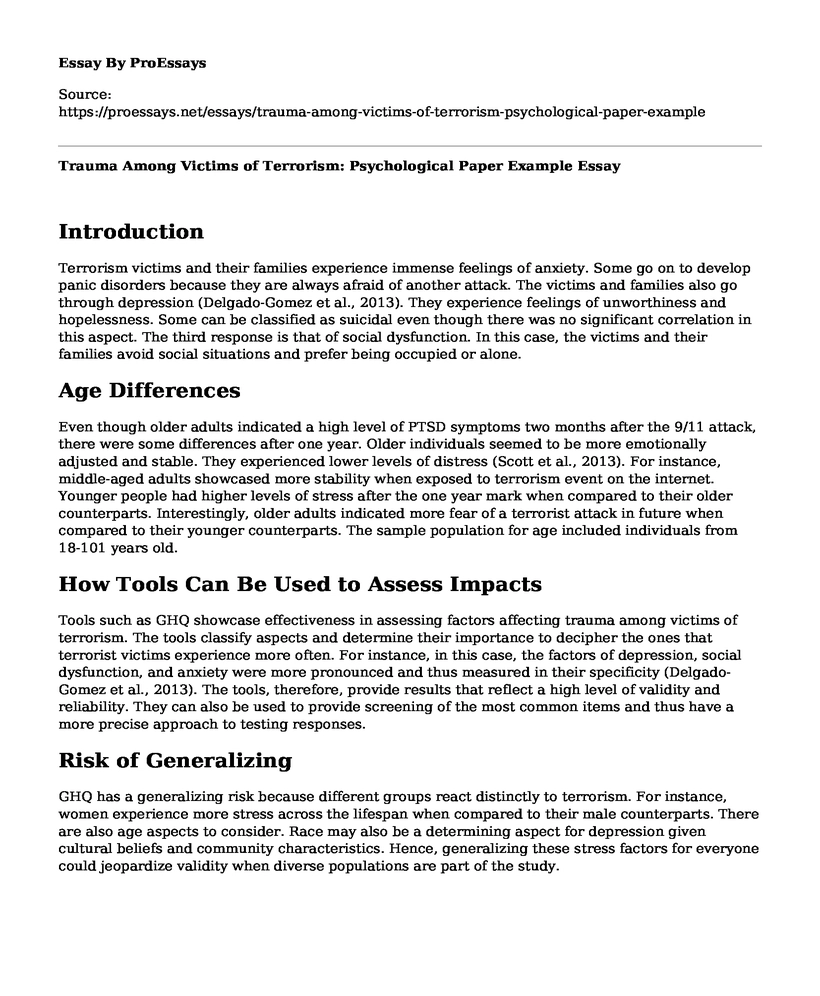Introduction
Terrorism victims and their families experience immense feelings of anxiety. Some go on to develop panic disorders because they are always afraid of another attack. The victims and families also go through depression (Delgado-Gomez et al., 2013). They experience feelings of unworthiness and hopelessness. Some can be classified as suicidal even though there was no significant correlation in this aspect. The third response is that of social dysfunction. In this case, the victims and their families avoid social situations and prefer being occupied or alone.
Age Differences
Even though older adults indicated a high level of PTSD symptoms two months after the 9/11 attack, there were some differences after one year. Older individuals seemed to be more emotionally adjusted and stable. They experienced lower levels of distress (Scott et al., 2013). For instance, middle-aged adults showcased more stability when exposed to terrorism event on the internet. Younger people had higher levels of stress after the one year mark when compared to their older counterparts. Interestingly, older adults indicated more fear of a terrorist attack in future when compared to their younger counterparts. The sample population for age included individuals from 18-101 years old.
How Tools Can Be Used to Assess Impacts
Tools such as GHQ showcase effectiveness in assessing factors affecting trauma among victims of terrorism. The tools classify aspects and determine their importance to decipher the ones that terrorist victims experience more often. For instance, in this case, the factors of depression, social dysfunction, and anxiety were more pronounced and thus measured in their specificity (Delgado-Gomez et al., 2013). The tools, therefore, provide results that reflect a high level of validity and reliability. They can also be used to provide screening of the most common items and thus have a more precise approach to testing responses.
Risk of Generalizing
GHQ has a generalizing risk because different groups react distinctly to terrorism. For instance, women experience more stress across the lifespan when compared to their male counterparts. There are also age aspects to consider. Race may also be a determining aspect for depression given cultural beliefs and community characteristics. Hence, generalizing these stress factors for everyone could jeopardize validity when diverse populations are part of the study.
References
Delgado-Gomez, D., Lopez-Castroman, J., de Leon-Martinez, V., Baca-Garcia, E., Cabanas-Arrate, M. L., Sanchez-Gonzalez, A., & Aguado, D. (2013). Psychometrical assessment and item analysis of the General Health Questionnaire in victims of terrorism. Psychological assessment, 25(1), 279.
Scott, S. B., Poulin, M. J., & Silver, R. C. (2013). A lifespan perspective on terrorism: Age differences in trajectories of response to 9/11. Developmental Psychology, 49(5), 986.
Cite this page
Trauma Among Victims of Terrorism: Psychological Paper Example. (2022, Apr 16). Retrieved from https://proessays.net/essays/trauma-among-victims-of-terrorism-psychological-paper-example
If you are the original author of this essay and no longer wish to have it published on the ProEssays website, please click below to request its removal:
- Syllabus Course on the Introduction to Fields of Addiction Review Paper
- Whole Women's Health V. Hellerstedt Paper Example
- Mental Health Counselor: Understanding Clients to Improve Their Lives - Essay Sample
- Child Homelessness: A Global Challenge - Research Paper
- Essay Example on Non-Profit Orgs Fight to End Poverty, Protect Children
- Essay Example on Processes of Life: Independence, Marriage, Parenthood, Seniority
- Alcohol Abuse Among Teens: Adverse Effects on Health & Future - Report Sample







